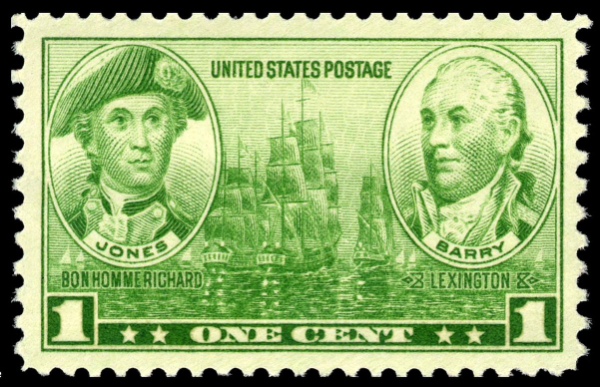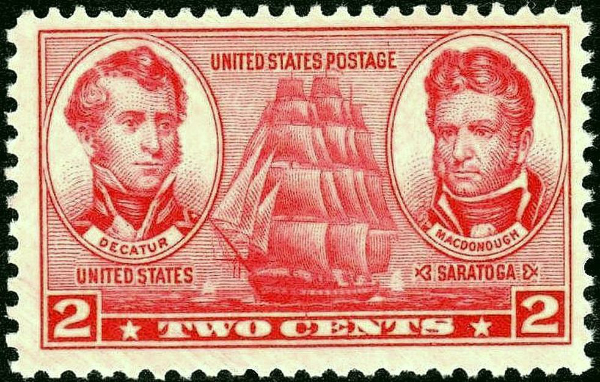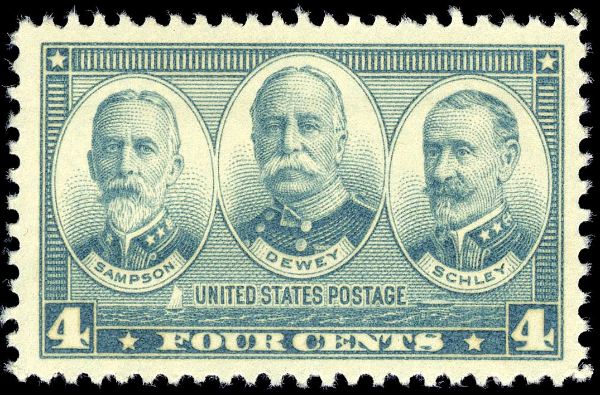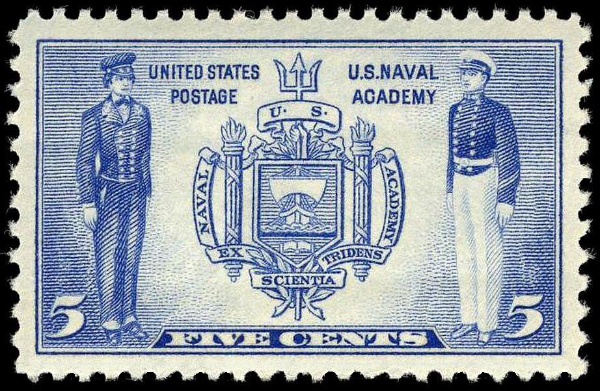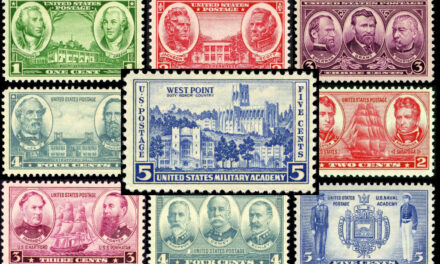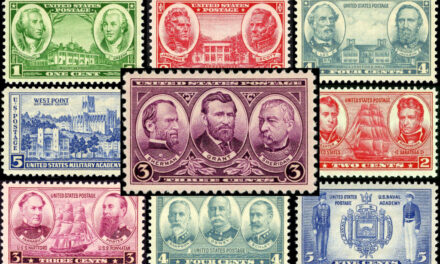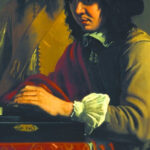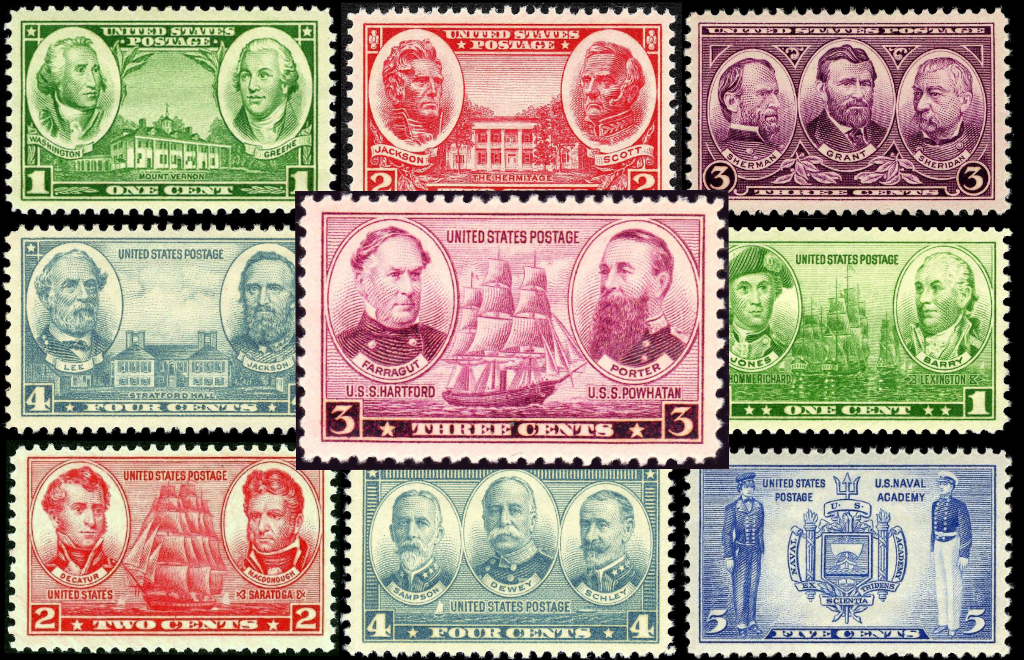
3-Cent 1937 Navy Stamp: David Farragut and David Dixon Porter
The 3-cent 1937 Navy stamp features portraits of two naval heroes from the Civil War, Admirals David Farragut and David Porter, who also happened to be adoptive brothers. Under each man’s portrait is the name of a ship under his command: Farragut’s USS Hartford and Porter’s USS Powhatan, respectively. The stamp also depicts a large Navy warship of the era.
The stamp is the third in a series of five stamps that were issued between December 1936 and May 1937 to commemorate some of the most important 18th- and 19th-century naval officers in American history. A parallel set of Army commemoratives, including the 3-cent Army stamp featuring Generals William Tecumseh Sherman, Ulysses S. Grant, and Philip Sheridan, was issued on the same dates as the Navy stamps.
The Design and Issuance of the 3-Cent 1937 Navy Stamp
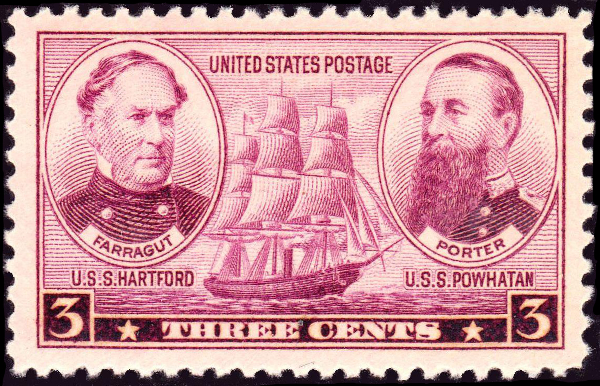
The 3-cent 1937 Navy stamp features Admirals David Farragut and David Dix Porter, naval heroes of the Civil War, along with a warship of the era. (U.S. Post Office — U.S. Bureau of Engraving and Printing, Public domain, via Wikimedia Commons)
The Other Stamps in the 1936–1937 Navy Series
Admiral David Farragut (1801–1870)
David Farragut, the adopted son of naval Captain David Porter, was commissioned as a midshipman in 1810 when he was just 9 years old. Serving aboard his adoptive father’s ship USS Essex, he fought in the War of 1812, becoming a prize master at the age of 12. He was wounded in battle and captured at Valparaiso Bay, Chile, in 1814.
In the 1820s, Farragut participated in the successful operations against pirates in the West Indies in the so-called “Mosquito Fleet.” He held various positions at sea and ashore and rose through the ranks, being promoted to lieutenant in 1825, commander in 1841, and captain in 1855.

David Glasgow Farragut in a portrait by William Swain, 1838. (National Portrait Gallery, Smithsonian Institution; transfer from the National Museum of American History; gift of the Estate of Loyall Farragut to the United States National Museum, 1917)
The Civil War: New Orleans and Mobile Bay
At the outbreak of the Civil War, Farragut offered his services to the Union, even though both he and his wife had been born in the South. In 1862, he was given command of the USS Hartford, the flagship of the West Gulf Blockading Squadron.
His first task was to take New Orleans from the Confederates—a major part of the Union strategy to split the Confederacy in two by gaining control of the Mississippi River. He captured New Orleans on April 29. Congress rewarded him by creating the rank of Rear Admiral for him.
Farragut’s second great victory of the war occurred in August 1864 at Mobile Bay, the last remaining Confederate port on the Gulf of Mexico. The bay was heavily protected with mines (called “torpedoes” at the time), and one ship from Farragut’s fleet was sunk.
When the other ships began to retreat, Farragut ordered them to continue the attack. Spurred on by Farragut, the fleet rallied to overcome the squadron led by Confederate Admiral Franklin Buchanan as well as heavy garrisons on shore to capture the port. Farragut’s order was famously paraphrased as, “Damn the torpedoes, full speed ahead!”
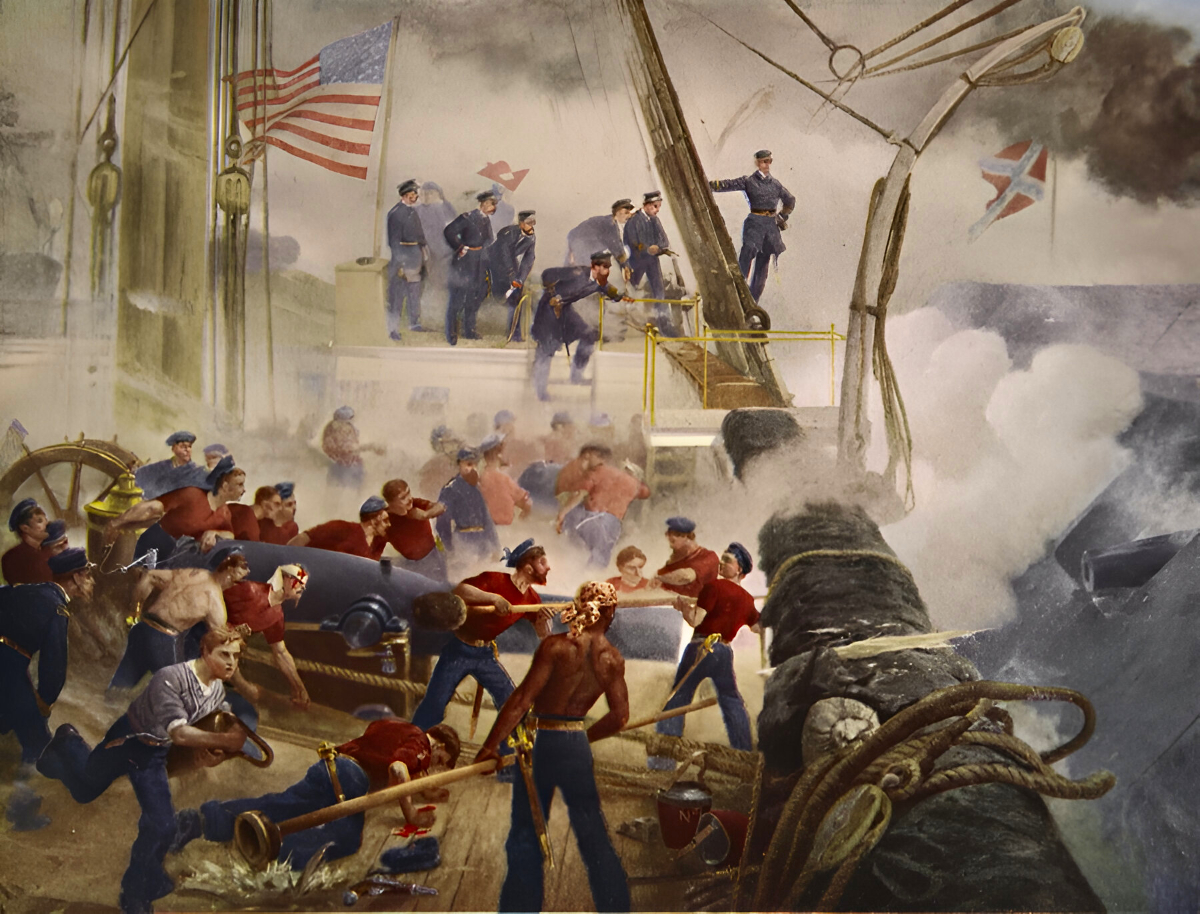
Farragut on the Hartford at Mobile Bay, August 5th 1864. (Henry Alexander Ogden, Public domain, via Wikimedia Commons)
The Navy’s First Admiral, on Active Duty for Life
In December 1864 President Lincoln promoted Farragut as the Navy’s Vice Admiral, and in 1866 he was promoted to Admiral, again the first in U.S. naval history. Farragut remained on active duty in the Navy for life—an honor reserved for only a few officers. He died in 1870.
Admiral David Porter (1813–1891)
David Dixon Porter was born into a prominent Navy family. His grandfather had served in the American Revolutionary War and his father had distinguished himself in the War of 1812. The father, Commodore David Porter, resigned from the U.S. Navy in 1824 and accepted an offer from Mexico to command its navy. The commodore took young David and another son with him as midshipmen.
In 1828, David was captured in a raid on Spanish ships in the harbor at Mariel, Cuba. He was held in a Havana prison until a prisoner exchange was arranged.
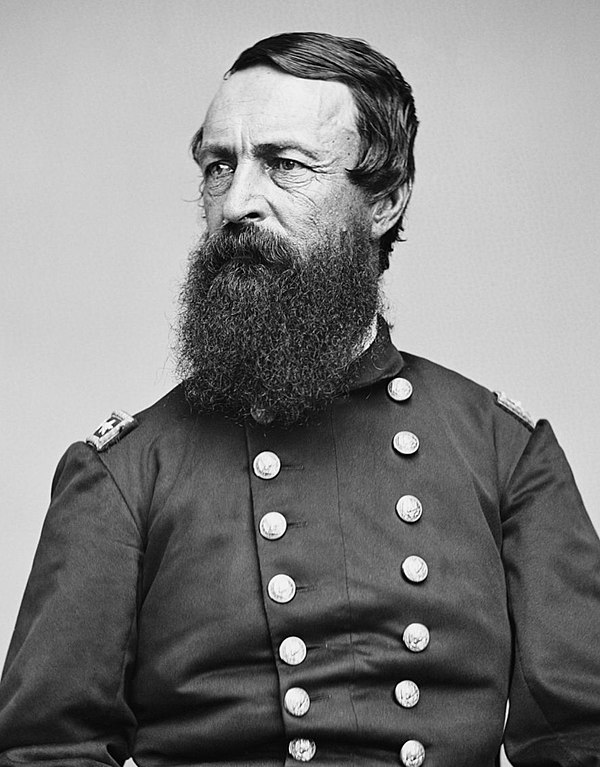
Photographic portrait of Rear Adm. David D. Porter by Mathew Brady, between 1860 and 1865. (Library of Congress, Public Domain, via Wikimedia Commons)
In 1829, Porter was appointed a midshipman in the U.S. Navy. In the peacetime Navy, he served aboard the USS United States and then was assigned to the Coast Survey. He was promoted to lieutenant in 1841, and in 1846 he undertook a private mission on behalf of the State Department to map and assess the new Republic of Santo Domingo.
The Mexican-American War: Porter’s First Command
During the Mexican-American War, although there was relatively little naval action, Porter served with distinction. As a first lieutenant on the USS Spitfire, he made a major contribution to the capture of Veracruz in March 1847 by proposing a successful plan to enter the well-protected harbor and bombard the forts and castle protecting the city. After he further distinguished himself in the Second Battle of Tabasco, he was given command of the Spitfire.
The Civil War: Vicksburg and Fort Fisher
Porter’s first assignment in the Civil War was the command of USS Powhatan in a secret mission to transport reinforcements to Fort Pickens in Florida. In 1862, he was put in command of a mortar fleet to bombard the two forts protecting New Orleans; after Farragut took the city, Porter forced the surrender of the forts.
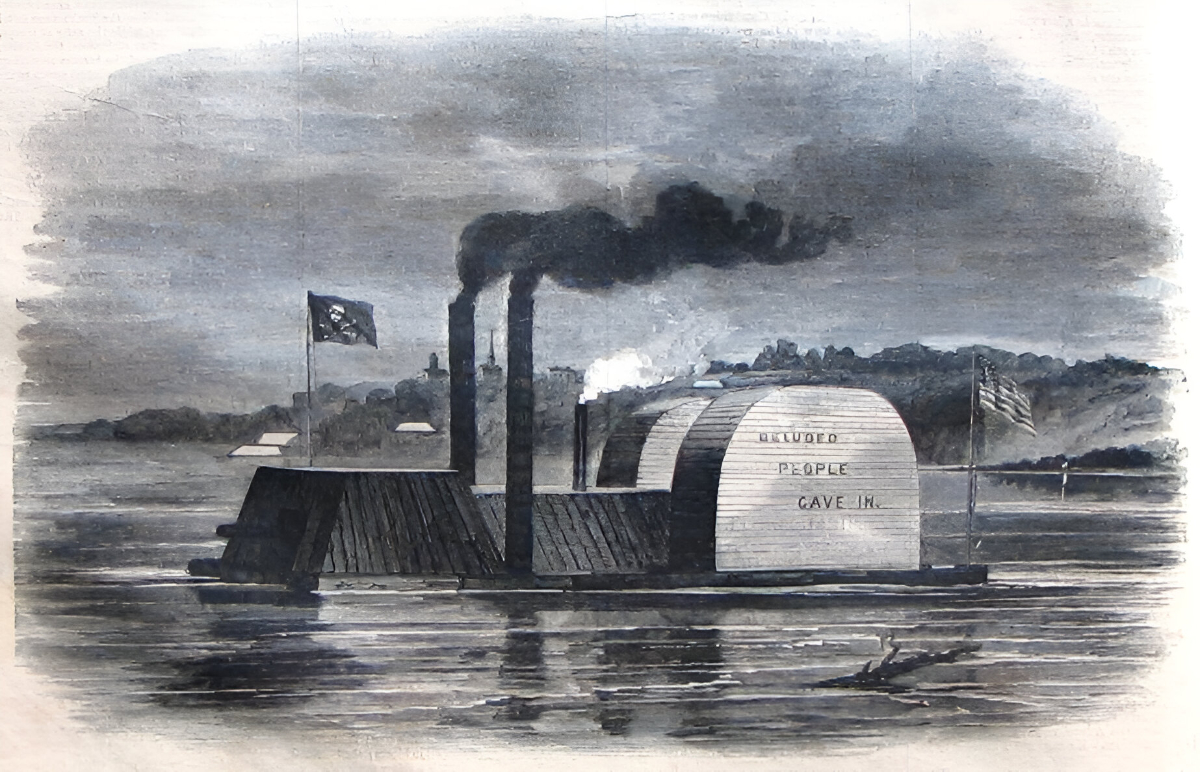
Admiral Porter's Second Dummy Frightening the Rebels at Vicksburg. Wood engraving after a sketch by Theodore Russel Davis. (Public domain, via Wikimedia Commons)
When the Navy was reorganized later in 1862, Porter was elevated to the rank of Acting Rear Admiral and assigned to command the new Mississippi River Squadron. Porter worked closely with General Grant and his Army in the siege of Vicksburg, maintaining a blockade of the city. After Vicksburg fell in July 1863, Porter’s rank of Rear Admiral was made permanent.
In late 1864, Porter’s command was transferred to the North Atlantic Blockading Squadron. Working in cooperation with Major General Alfred H. Terry of the Army, Porter engineered a successful assault on Fort Fisher in North Carolina, which closed the port of Wilmington, the last remaining Atlantic Confederate port. The defeat of Fort Fisher was the last major naval operation of the war.
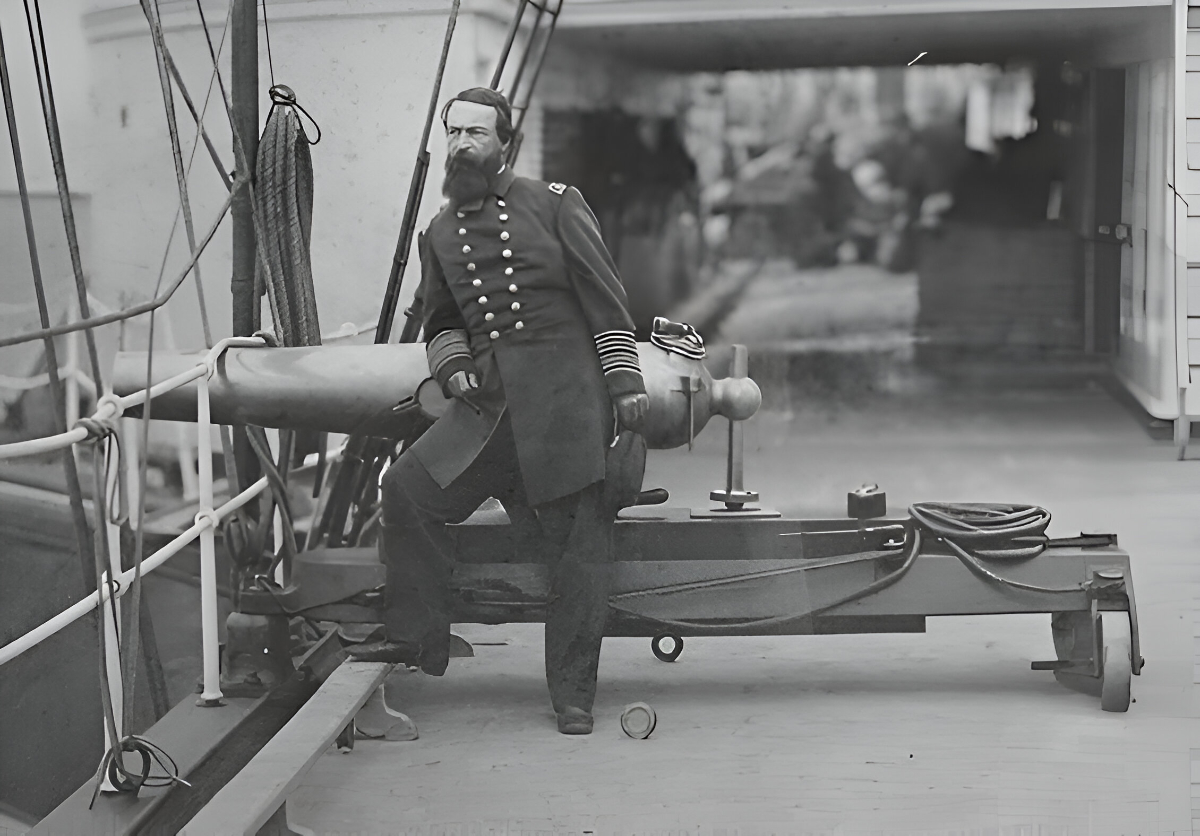
Rear Admiral David Dixon Porter, USN, Commander, North Atlantic Blockading Squadron, on the main deck of his flagship, USS Malvern, 1864. (Photographic Section, Department of the Navy, Naval Historical Center, Public domain, via Wikimedia Commons)
Superintendent of the Naval Academy
After the war, Porter was appointed superintendent of the Naval Academy at Annapolis, Maryland. He reformed and modernized the Academy, bringing in new faculty, revising the curriculum, instilling discipline, and setting up an honor system.
In 1866, when the Navy created the new ranks of Admiral and Vice Admiral, Porter became Vice Admiral as Farragut, his adoptive brother, was named the Navy’s first Admiral. After Farragut’s death in 1870, Porter succeeded him as Admiral, but having made numerous enemies throughout the years, his influence declined and he had little say in naval matters for the last twenty years before his death in 1891.
Early American Naval History Commemorated
Admirals David Farragut and David Dixon Porter were the most prominent naval heroes of the Civil War. When the Post Office created the 1936–1937 Army-Navy commemorative series, these two men were the obvious Civil War-era officers to be honored on the 3-cent 1937 Navy stamp. The fact that they were adoptive brothers adds additional interest to the stamp.
This stamp and the others in the series provide a gateway to learning about important figures, events, and places in American history. The United States has issued hundreds of commemorative postage stamps that tell the nation’s story, and thousands more stamps of historical interest have been issued worldwide. Collecting stamps, especially commemorative issues, can be a great way to learn about history.
Copyright © Brian Lokker 2012, 2024. An earlier version of this article was published on HubPages.com in 2012 and was subsequently featured on HobbyLark.com.

